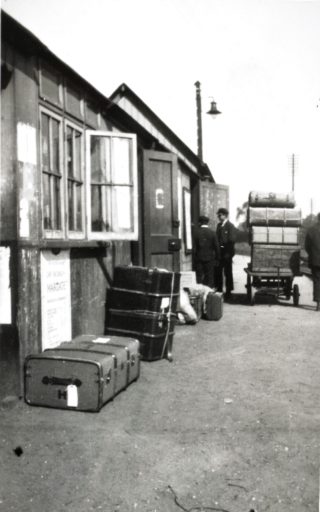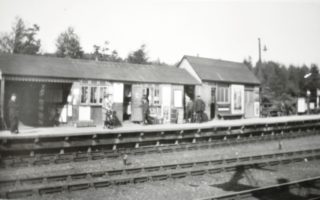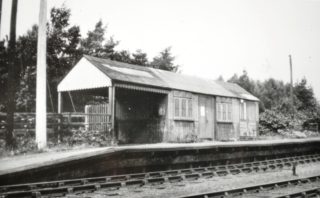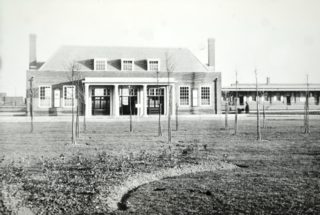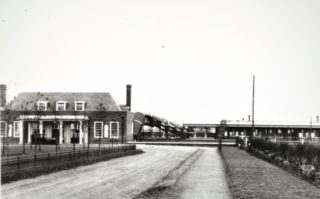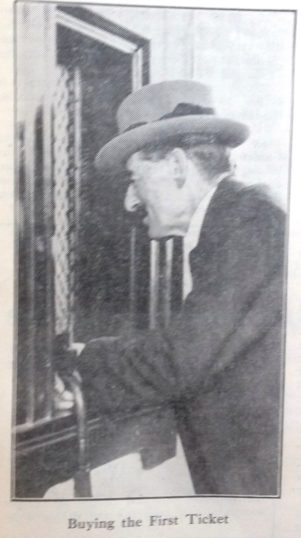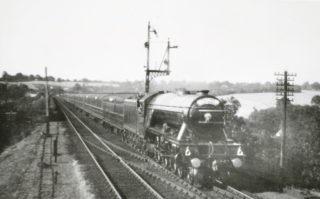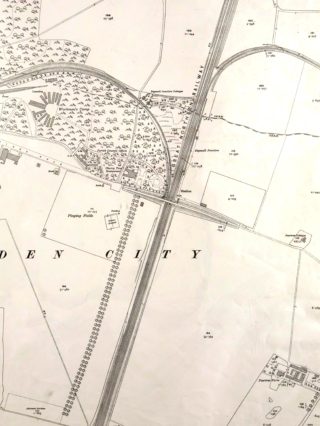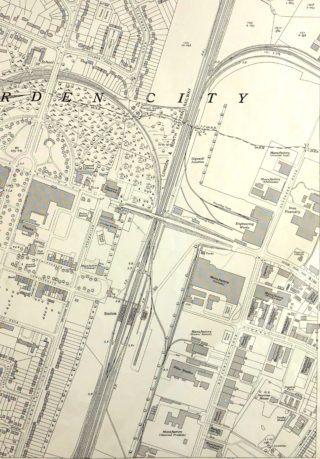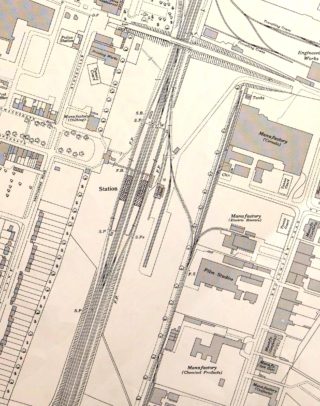Welwyn Garden City Station
Susan Hall
On Friday 17 September 1926 the Welwyn Garden City News printed the following article on page one of the paper:
Railway History
The opening of the new main line station on Monday will be an important landmark in the history of local railway development, for it will link up for the first time the three lines which now run through the Garden City. It will be the third (and not the second) station established to serve the district.
The first station, known as Welwyn Junction, was opened in 1858, and was designed to serve the branch line to Hertford. This line was constructed by a separate railway company, known as the Hertford and Welwyn Junction Railway Company which was incorporated by an Act of 1854, with the object of constructing a line from Hertford to join the Great Northern main line in both northerly and southerly directions. The southern curve only was completed, however, and Welwyn Junction station was built to provide for the interchange of traffic. Two years later a through service was instituted between Hatfield and Hertford and Welwyn Junction station fell into disuse.
Mr Oscar Corble, who read a paper on the history of local railways at the Regional Survey meeting in the Lawrence Hall a couple of months ago, stated that traces of the old station platform had quite recently been unearthed very close to the spot where the new main line station has been constructed.
The Luton and Dunstable branch line on which the present temporary station is situated was all so inaugurated as an independent concern by a company in 1855, known as the Luton, Dunstable and Welwyn Branch Railway. The object of this company was to construct a line between Luton and Dunstable and to connect it with the Hertford and Welwyn Railway. The section between Luton and Dunstable, according to Mr Corble, was opened in May 1858, but it was not until after the amalgamation of the Luton and Dunstable Railway with the Hertford and Welwyn Railway that the present line was completed. It was then carried into Hatfield instead of crossing the Great Northern main line to connect with the Hertford line, and this seems to account for the peculiar construction of the local railway system.
A system of railway development by means of small independent companies did not survive for very long, and the difficulty of finding adequate capital for development and the limitations to the revenue-earning capacities of the district concerned enforced a process of amalgamation with the larger companies which has continued quietly right down at the present time.
As far as the local lines are concerned, amalgamation started with the fusion of the Luton and Dunstable with the Hertfordshire and Welwyn Junction Railway, and then, in 1861, with the absorption of the branch lines by the Great Northern Company. The Great Northern itself was the result of an amalgamation of two rival schemes – the District Northern and the London to York, which after a long parliamentary battle in 1845, became amalgamated under the more familiar title of the Great Northern Railway Company.
The’ New’ station started its life in 1925. The following article appeared on the front page of the Welwyn Garden City News on 16 October 1925:
The excavations for the beds of the platform walls of the New Station are being dug. The two island platforms, each of which will be 648 feet long, will be erected between the Luton and Hertford branch lines, which were recently curved for this purpose. To cover six acres, the new station premises will be built in Georgian style, and will be equipped with every modern convenience and comfort, including central heating. Flower beds will surround the platforms. Covered ways and footbridge will be provided, and the platforms will be roofed over. “crossovers” will enable main line trains to be diverted to the platforms as required.
The increased facilities thus afforded of direct communication with London and the North and Hertford and the Southern Counties, will be of great value to the commercial and industrial life, as well as to private people. Luton and Dunstable are already directly connected with Welwyn Garden City.
The station and its approaches will be such that Welwyn Garden citizens may be proud of, and visitors come from afar to admire.
Even before the foundations were laid work had to be carried out on the two branch lines to make way for the ‘down main line’. On 21 August 1925 it was reported that ‘The moving of the Luton branch line, which is proceeding to a position 45 feet westwards. The Hertford branch line will be similarly moved eastwards’.
The Welwyn Garden City News reported on 8 October 1926, the opening ceremony of the ‘new’ station. There was a large crowd assembled at the bottom of Parkway to witness the event. At 12.15 a special train arrived from London carrying the Right Honorable Neville Chamberlain MP, Minister of Health.
He was accompanied by Mr William Whitelaw, Chairman of the Board of Directors of the LNER, Mr Raymond Unwin chief Town Planning Adviser to the Ministry of Health and other dignitaries. They were met by Sir Theodore Chambers, Chairman of the Garden City Company, Mr Ebenezer Howard, founder of Letchworth and Welwyn Garden Cities and a large number of other County and Rural District Councillors.
The party left the platform by means of the level crossing, and after passing through a troop of Girl Guides who lined the route, they ascended a wooden gangway over a low parapet wall, which surrounded the goods yard, and arrived outside the main entrance to the station.
A temporary platform had been erected and a large pair of blue curtains screened the entrance hall from public view
Mr William Whitelaw presided at the ceremony and he said ” to the marked advance which the opening of the station indicated in the history of Welwyn Garden City, and of the big step which had been made in the cooperation between the LNER and those responsible for the building and growth of this wonderful garden city. It would be impossible for anything to be more appropriate than that upon such an occasion they should be honoured by the presence of Mr Chamberlain, who one day would be recognized by everybody as the man who rebuilt England.
Mr Chamberlain was then asked to pull aside the curtains and make use of the silver key to open the station, he said ” Mr Whitelaw, ladies and gentlemen, this is not the first time that I have visited Welwyn Garden City, and it is to me a matter of intense gratification that since I was last here, though it was but a short time ago, the aspect of the place has so immensely developed. I understand I am to have another opportunity of making some observations about Welwyn Garden City. I only therefore now wish to say to you that I esteem it a great privilege to be able to take part in this great inauguration ceremony in the development of the model Garden City of Welwyn”.
The Minister then pulled the string and the curtain drew back revealing the magnificent double doors leading to the booking hall. These were opened and the party entered the station and preceded with a grand tour of inspection. They crossed to the island platforms by the means of the covered bridge and the posed for photographs in front of one of the station name boards. On returning to the booking hall, Mr Chamberlain purchased the first ticket to be issued after the formal opening.
After the ceremony they ventured to the Parkway Hall, where luncheon was served to 150 guests, the chairman, Sir Theodore Chambers welcomed Mr Chamberlain and said there was something striking to residents of Welwyn Garden City about the sudden geographical transference of a railway station from an obscure branch line to one of the great main trunk lines of Great Britain. It was an event of great importance in the history of any town, and he thought it very appropriate that on this occasion, a “milestone in our progress” that we should have His Majesty’s Minister of Health with us.
The Welwyn to Hertford branch line closed to passengers in on 18 June 1951, the last train being the 7.18pm train from Hertford North station. There were two Railtour passenger trains after that date, one in 1959 the other in 1961. A goods service to Hertford North remained until 18 April 1966. As part of the Beeching cuts, the Welwyn to Hertford branch line closed to all traffic on 23 May 1966. It is now forms part of the Cole Green Way The old railway line, creates a green route from Welwyn Garden City to Hertford. It also forms part of Route 61 of the National Cycle Network. The Cole Green Way proper runs from the outskirts of Welwyn Garden City at the Black Fan Road / Cole Green Lane junction to West Street in Hertford. This rural section follows the former railway and is suitable for walkers, cyclists and horse riders. This part of the route is also accessible for disabled visitors at various points. Motorised scooter wheelchairs are probably the best option due to the nature of the surfacing. There are links at both ends that take walkers and cyclists into Welwyn and Hertford town centres.
The Victorian brick bridges and the platform at Cole Green remain as the only reminders of its past.
The Luton and Dunstable branch line also closed in the 1960s and parts of it now form the Ayot Greenway cycle route running from Welwyn Garden City to Wheathampstead. The Ayots section runs along the old railway line through Sherrardspark Woods, and then through Ayot Green, being dissected by the A1(M) motorway.
Welwyn Garden City station closed its doors towards the end of the 1980s, the present station, is dominated by “The Howard Centre” , a shopping precinct which opened its doors in October 1990. The old platforms remain very much the same, but with the addition of lifts down to the platforms from the footbridge.
